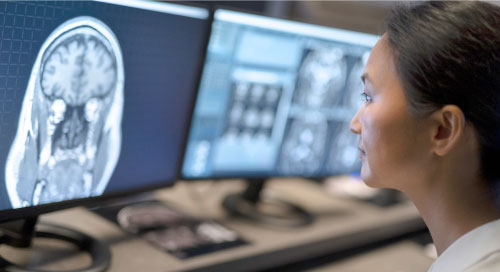Fill form to unlock content
Error - something went wrong!
Stay up to date with the latest IoT and network edge news.
Subscribed.
AI Radiology Assistant Helps Underserved Communities

Statistics indicate there’s only one radiologist for every 100,000 people in developing countries, which makes capturing and analyzing X-ray images a major bottleneck in diagnostic healthcare. And it’s not just a shortage of professionals at issue: The gap in infrastructure is also a problem. In a well-equipped US hospital, a radiologist might analyze 200 or more X-rays a day; in an underfunded rural Indian hospital with less sophisticated equipment, analyzing 100 X-rays a day is difficult.
And it’s not just X-rays that radiologists must look at. They constantly have to make tough decisions on how to split their time between modalities such as X-ray, CT, and MRI, especially when they are asked to prioritize CT and MRI scans. All of this combined can create quite the backlog of unexamined X-rays.
To address these issues, radiology advancements such as AI-based clinical decision support (CDS) tools are emerging to help radiologists diagnose X-rays more quickly without compromising quality.
The Benefits of Clinical Decision Support
As the name indicates, a clinical decision support tool is designed to help clinicians analyze images and make decisions. These tools can take on many forms, such as rule-based systems, mapping-based systems, productivity, or automation systems.
Over the past decade, AI-based CDS tools have risen to prominence in virtually every field of medicine that could benefit from the automated analysis of electronic health records (EHRs) and other clinical data. This rapid growth has been driven in part by the reduced cost of using AI to review patient data, as well as new regulatory guidelines from authorities like the FDA that are smoothing the path to adoption for CDS broadly and for AI in particular.
But although the costs of AI-assisted imaging have come down dramatically over the past decade, the technology has remained out of reach for poorer regions. Part of the problem is that AI radiology solutions have focused on specific diagnoses such as tuberculosis or cystic fibrosis. To have a full diagnostic suite, a clinic would need multiple AI solutions, driving up costs.
This focus on specific conditions also limits the tools’ ability to save radiologists time—particularly when it comes to X-rays. “When a patient takes a chest X-ray, you don’t know whether he has condition A or condition B,” explains Mukundakumar Chettiar, Head of the Digital Health Initiative within the medical business unit at L&T Technology Services (LTTS). “Chest X-rays are used as a screening tool, so you don’t necessarily know what you are looking for.”
Over the past decade, #AI-based CDS tools have risen to prominence in virtually every field of #medicine that could benefit from the automated analysis of electronic #health records (EHRs) and other clinical #data. @LnTTechservices via @insightdottech
The Need for General-Purpose Systems
LTTS developed Chest-rAI, a general-purpose X-ray CDS tool that aims to provide a more holistic approach to AI-assisted imaging. Rather than looking for a particular condition, Chest-rAI examines X-rays for a broad spectrum of abnormalities and potential biomarkers. The tool covers more than 85% of diagnoses encountered at a medical institution and has an accuracy rate of over 92%.
To reach these numbers, Chest-rAI leverages a novel deep learning architecture called Convolution Attention-based sentence Reconstruction and Scoring (CARES). CARES extracts features from radiological images and generates grammatically and clinically correct reports describing its findings, according to Chettiar. Chest-rAI also uses a unique scoring mechanism called the Radiological Finding Quality Index to evaluate the exact radiological findings, localize them, and determine the size/severity for each term present in the report.
In addition, Intel® AI Analytics and OpenVINO™ toolkits are used to optimize the inference pipeline and reduce analysis turnaround time from eight weeks in most cases to as little as two weeks—and radiologists can access the reports remotely using a web-based interface. The Intel® Extensions for PyTorch (IPEX) is also used to optimize performance. This combination of automated reporting, quick turnaround, and remote access dramatically improves radiologists’ ability to meet the needs of underserved populations.
“Using the Intel toolkits helped our team speed up inference by 1.84 times and cut turnaround time by 75%,” says Nandish S., AI Engineer at LTTS. “And it helped reduce the model size by nearly 40%.”
Because it is highly optimized, Chest-rAI can be deployed in many forms: in the cloud, in on-premises solutions, or at the edge as an embedded solution. This gives hospitals the flexibility to adopt the solution however it best suits their budget and existing infrastructure.
Chest-rAI CDS easily integrates with existing hospital systems and can be used as a standalone application or part of a larger system. The integration process is designed for simplicity, allowing the CDS to get up and running in a matter of days when being tied into existing hospital systems like Picture Archiving and Communication Systems (PACS) and Radiology Information Systems (RIS).
A Smarter, More Affordable Radiology Solution
Over the past decade, AI-based tools have transformed many fields, driving better outcomes across many applications—breast cancer screening, diabetic retinopathies, classification of skin lesions, prediction of septic shocks, and more.
Despite these radiology advancements, radiologist workloads have become a bottleneck to the healthcare system, especially in developing countries. Existing tools have been too narrowly focused to meet the needs of broad screening modalities like X-rays. With the emergence of more general-purpose tools like LTTS’ Chest-rAI, radiologists now have a tool that not only saves them time but also allows them to serve a larger population—just what’s needed in many rural hospitals.
This article was edited by Christina Cardoza, Associate Editorial Director for insight.tech.